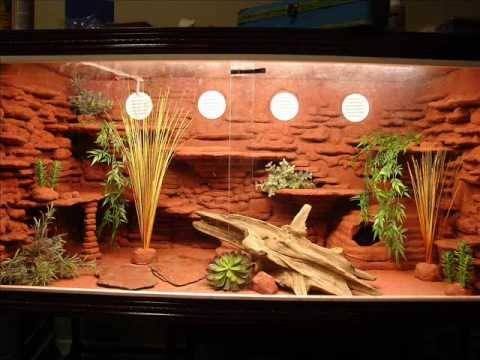
UROMASTYX HUSBANDRY GUIDE
Habitat Specifications
Uromastyx are arid reptiles and their habitats need to reflect this. But, this road is not narrow, you have options. Overall it's important to create a habitat that maintains humidity levels appropriate for your Uromastyx and has correct lighting. Outside of this, you have choices; let's talk about them. Uromastyx are hardy animals that are relatively simple to care for. They don't mind being handled and can work well for kids. When properly socialized they are docile and relatively safe. They are semi-arboreal which means they need access to climbing opportunities. This also aids in giving them mental stimulation. Uromastyx also enjoy digging which is a helpful feature provided by bioactive setups. They will eat plants so it's important that you use live plants that are Uromastyx safe if you include plants in your setup. Speaking of setups, let's chat about options.
Bioactive Enclosure
To substrate or not to substrate…that is the question. Long story short…folks say substrate equals impaction. My stance…it's not that simple (I'll explain later). I am on team substrate because I am on team bioactive. Before we dive deep into the world of bioactivity, we need to address the fact that all substrates are not created equal. I won't explain it in-depth but, calcium sand is a no-no, and so are things like mulch and/or small bark. Using these materials can put the lives of your reptiles at risk. Now that that’s out of the way, let's talk arid bioactive setups.
Overall, bioactive enclosures allow you to create an entire ecosystem in a small space. The main components are plants, a substrate meant for arid environments, leaf litter, and the clean-up-crew consisting of isopods, springtails, and other insect friends. Decor items are also important, consisting of medium to large wood of some kind for climbing and décor, a hide, a basking stone slab, a surface to put the feeding bowl on, and more.
The substrate is key. It provides a home for all the insects and organisms that work hard to keep the enclosure clean. It needs to have the ability to dry out quickly, yet it needs to hold enough moisture to keep the clean-up crew alive and water plants. The best substrate of choice contains dirt with a small about of moss to hold moisture and sand and rocks for easy drainage. I spray the substrate down every morning to maintain a balanced environment for the clean-up crew, to prevent the substrate from becoming too dusty, and to give my Uros a shower. It's important you don't spray too much. The goal is slightly moist, not wet. My setups provide my Uros with multiple outlets for stimulation; digging, climbing, hunting insects, and eating their plants.
Before we move on from bioactive setups It's important we chat about impaction. Impaction is a potentially deadly medical condition that simply said, means the reptile's digestive system is blocked with material that can not be defecated. Many reptile keepers are strongly against substrate because they believe it will inevitably lead to impaction and death. The truth is, when using an appropriate substrate, it alone won't lead to impaction. Impaction requires a couple of factors, with the main one being improper husbandry. Reptiles need heat to properly digest the things they consume, food and otherwise. Proper amounts of UVB and hydration are also important to this process. Healthy animals, cared for with proper husbandry, are at extremely low risk of impaction. Combine proper husbandry with appropriate substrate and that risk almost completely disappears. Proper husbandry, in all areas of reptile care, is key.
Bare Bottom/Hard Bottom Enclosure
Bare bottom/hard bottom enclosures require maintenance than bioactive setups, but are much simpler. This is their upside. Just as the name suggests, the bottom of the enclosure is hard in some way. This can range from being bare glass bottom or ceramic tiles, potentially covered with paper towels, maybe even puppy pads to make cleanup easier (We will cover this in more detail). Outside of this difference, many of the same elements needed in a bioactive enclosure (a hide, climbing surfaces, food dish, etc) are important in hard-bottom enclosures as well. You must keep up with cleaning to prevent illness.


Disposable base material
Starting with a hard bottom base, you can add disposable base material like paper towels, newspaper, newsprint paper, etc., that can be easily removed and replaced when soiled. This option makes cleaning easier and is simple for beginners. The base material is usually easier for your reptile to get traction on with walking/running. The downside is that paper material may not be sturdy and may tear easily. This can lead to smeared waste and complicate your cleaning process slightly. In all honesty, your reptile is going to smear its waste at some point, no matter which enclosure method you pick. There is also a small chance your reptile may consume the paper material, and this could lead to issues.
Removable and washable base material
Starting with a hard bottom base, you can add reusable base material like rubber padding, silicone pad, etc., that can be easily removed and cleaned when soiled. This option makes cleaning straightforward and is also a simple method for beginners. I do not recommend using reptile carpet or any other cloth/fabric/carpet-based material. Reptile carpet can cause physical harm to your reptile, and it can harbor bacteria. I can not stress enough the danger carpet materials pose. A base material of rubber/silicone is usually easier for your reptile to get traction than tile when walking/running. The downside is you will likely have to remove all/most of the elements in your enclosure on cleaning days. This may also be required with the other methods above as well, depending on how you create your setup.
UVB and Heat Lighting
Proper lighting is critical to the health of your reptiles. The ideal lighting schedule is 12 hours of light/12 hours of "night". The best way to accomplish this is with a timer set to turn on after sunrise and off after sunset.
Uromastyx need a linear T5 UVB light bulb and fixture, as well as a basking/heat lamp. The best UVB bulbs in my opinion are 14% Arcadia D3 Desert T5. There are other reliable brands, but Arcadia bulbs last longer. Heat domes can be combined with a variety of different household incandescent bulbs to produce heat. I prefer to use heat dome fixtures with a dimmer switch for greater temperature control. Note: High-efficiency bulbs will not produce a meaningful amount of heat. Our line of halogen basking bulbs are high quality.
Getting the right lighting setup will mean life and death for your reptile. UVB makes it possible for reptiles to process calcium and prevent the dreaded Metabolic Bone Disease (MBD). Reptiles are cold-blooded creatures and are incapable of producing their own body heat. The basking spot provides the heat needed for food digestion and other metabolic needs. It's important that you also take care of the needs of your plants. Reptile and clean-up crew waste can help provide plants with food, misting with fill most (maybe all) of their water needs, the only gap left is UVA light. Adding lights for your plants will lead to healthier and happy plants.
Humidity and Temperature
Monitoring the temperatures and humidity in the enclosure is another critically important aspect of husbandry. It's important to balance the two correctly. To do this properly, a digital hygrometer/thermometer is needed.
Temperature: The ambient temperature in the enclosure needs a hot and cool side. This is called a temperature gradient. The cool side needs to be at least a 10 - 15 degrees lower than the hot side. Aim for an ambient temperature between 90-80 degrees Fahrenheit on the hot side and 80-75 on the cool side for Uromastyx.
Basking Temperature: This is the surface temperature of the reptile’s basking spot. This must be measured with an infrared thermometer. Reptile digest their food with belly heat. Selecting the right temperatures can be nuanced, but a general rule is to aim for a basking temperature between 110 and 135 degrees Fahrenheit for Uromastyx.
Humidity: Uromastyx are desert animals but this doesn’t mean their habitat should be bone dry. Humidity is important to hydration and important body functions. For Uromastyx, the question of humidity needs to be nuanced depending on the subspecies. You want to aim for humidity levels between 30-60%, providing humidity spikes in the mornings. This can be accomplished by misting your enclosure 2-3 times a week, more if needed. It’s better to mist at the start of their day, the heat from their basking light will dry the moisture and help with preventing mold and other issues. I add computer fans to all my enclosures to help with air movement and ventilation. Ventilation is important in preventing respiratory infections.
Enclosure specifications
I recommend a minimum enclosure size of 4'x 2'x 2', but the more room you can give your reptiles the better.
Depending on the subspecies, Uros love to climb. Create a network of climbing branches in their space. You can use anything from dowels to sticks you find outside. When using sticks you harvested, make sure they are not from sap-producing trees or trees with toxic qualities such as eucalyptus or pine/redwood. You also need to properly sanitize and materials you collect in nature for your enclosure.
Using backgrounds to make the walls of your enclosure climbable is a great way to add enrichment and climbing opportunities as well.
Providing belly heat for your Uro is important for their digestive health. DO NOT USE AN ELECTRIC HEAT ROCK. Electric heat rocks are dangerous and can cause severe injury to your reptile. Instead, use natural paver stones under their basking light. The stones will retain the heat from the basking light and radiate back it when your dragon lays on the stones.
Provide at least one but ideally two hides, one on the hot/basking side and one on the cool side.


